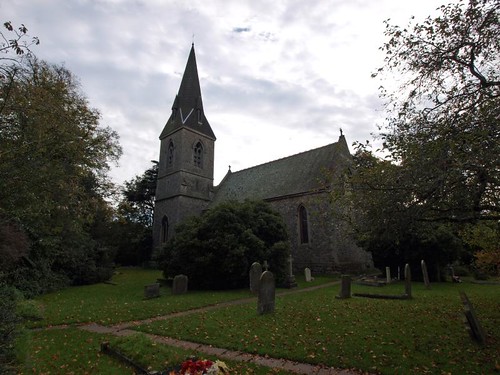All Saints building was designed by Richard Armstrong and was funded
by the then owner of Cranham Hall, Richard Benyon, to the cost of £5,114. It was
built of stone in the early English style and consists of chancel, nave, south porch
and north tower.
Rather surprisingly Pevsner missed it.
CRANHAM. Its graceful spire draws us from miles away to a church refashioned last century. It has some Tudor bricks in its walls, and there are others in the garden wall of the hall, which stands close by with a good cedar before it. It was here that General Oglethorpe came to live at the end of his adventurous life; and here they laid him to rest in 1785. The church has a marble inscription (covering most of the chancel wall) put up by his widow to tell of his life and virtues, and of the deed by which he will always be remembered, the founding of Georgia. We read, too, the quaint thought Alexander Pope had about him, that
One driven by strong benevolence of soul
Shall fly like Oglethorpe from Pole to Pole.
Entering Parliament for Haslemere, he came in contact with the horrors of our prison system, and, first of prison reformers, brought the matter before Parliament in 1729. Three years later he organised a scheme for the colonisation of Georgia, with the double purpose of relieving poor debtors and checking Spanish aggression. He took out with him John and Charles Wesley, and when Charles came home appointed George Whitefield in his stead. A high-souled Governor, Oglethorpe firmly banned both rum and slavery, a policy very difficult to enforce. Trouble with the Wesleys added to his burden, but he carried all before him, and came home bringing with him a number of Red Indian chiefs with whom, as with all their people, he maintained the happiest relations. War broke out with Spain, and his military conduct in the colony was such that after final victory Whitefield wrote that “The deliverance is such as cannot be paralleled but by some instance out of the Old Testament.”
Oglethorpe was poorly supported at home, where the Government refused to meet the bills they had authorised him to draw on behalf of the colony; and had he not made a fortunate and happy marriage, which brought him an estate at Cranham, he must have been ruined. It was this village therefore that saved a great reputation.
It was the Stuart rising of 1745 that ended his Georgian career. Sent North to fight under Wade, he was absurdly accused of excessive sympathy with the enemy, and though a courtmartial acquitted him, he lost his seat in Parliament and retired into private life, befriending scholars and making his house a centre of learning and happy society. Dr Johnson said to him, “I know no man whose Life would be more interesting; if I were furnished with materials I should be very glad to write it.” That chance was missed, and Boswell, to whom Oglethorpe did give some details for the purpose, also let slip the great opportunity. Oglethorpe died suddenly at 89.
One driven by strong benevolence of soul
Shall fly like Oglethorpe from Pole to Pole.
Entering Parliament for Haslemere, he came in contact with the horrors of our prison system, and, first of prison reformers, brought the matter before Parliament in 1729. Three years later he organised a scheme for the colonisation of Georgia, with the double purpose of relieving poor debtors and checking Spanish aggression. He took out with him John and Charles Wesley, and when Charles came home appointed George Whitefield in his stead. A high-souled Governor, Oglethorpe firmly banned both rum and slavery, a policy very difficult to enforce. Trouble with the Wesleys added to his burden, but he carried all before him, and came home bringing with him a number of Red Indian chiefs with whom, as with all their people, he maintained the happiest relations. War broke out with Spain, and his military conduct in the colony was such that after final victory Whitefield wrote that “The deliverance is such as cannot be paralleled but by some instance out of the Old Testament.”
Oglethorpe was poorly supported at home, where the Government refused to meet the bills they had authorised him to draw on behalf of the colony; and had he not made a fortunate and happy marriage, which brought him an estate at Cranham, he must have been ruined. It was this village therefore that saved a great reputation.
It was the Stuart rising of 1745 that ended his Georgian career. Sent North to fight under Wade, he was absurdly accused of excessive sympathy with the enemy, and though a courtmartial acquitted him, he lost his seat in Parliament and retired into private life, befriending scholars and making his house a centre of learning and happy society. Dr Johnson said to him, “I know no man whose Life would be more interesting; if I were furnished with materials I should be very glad to write it.” That chance was missed, and Boswell, to whom Oglethorpe did give some details for the purpose, also let slip the great opportunity. Oglethorpe died suddenly at 89.

No comments:
Post a Comment